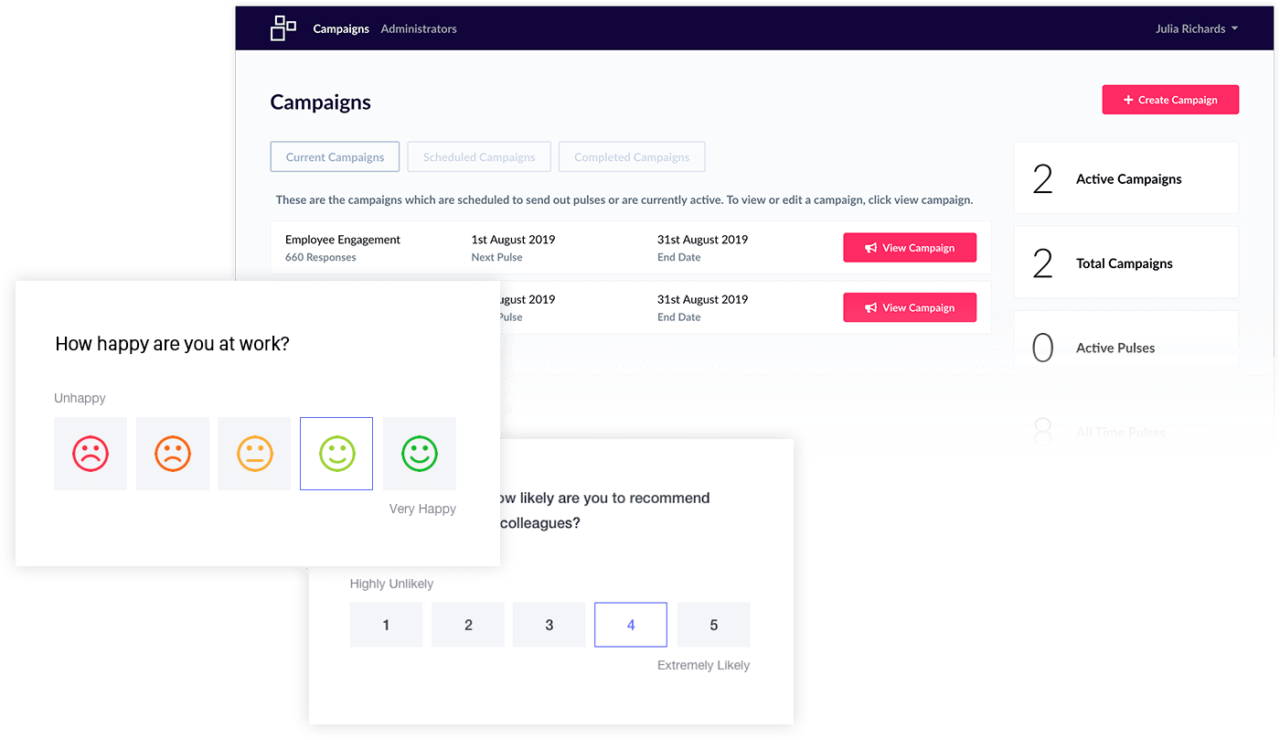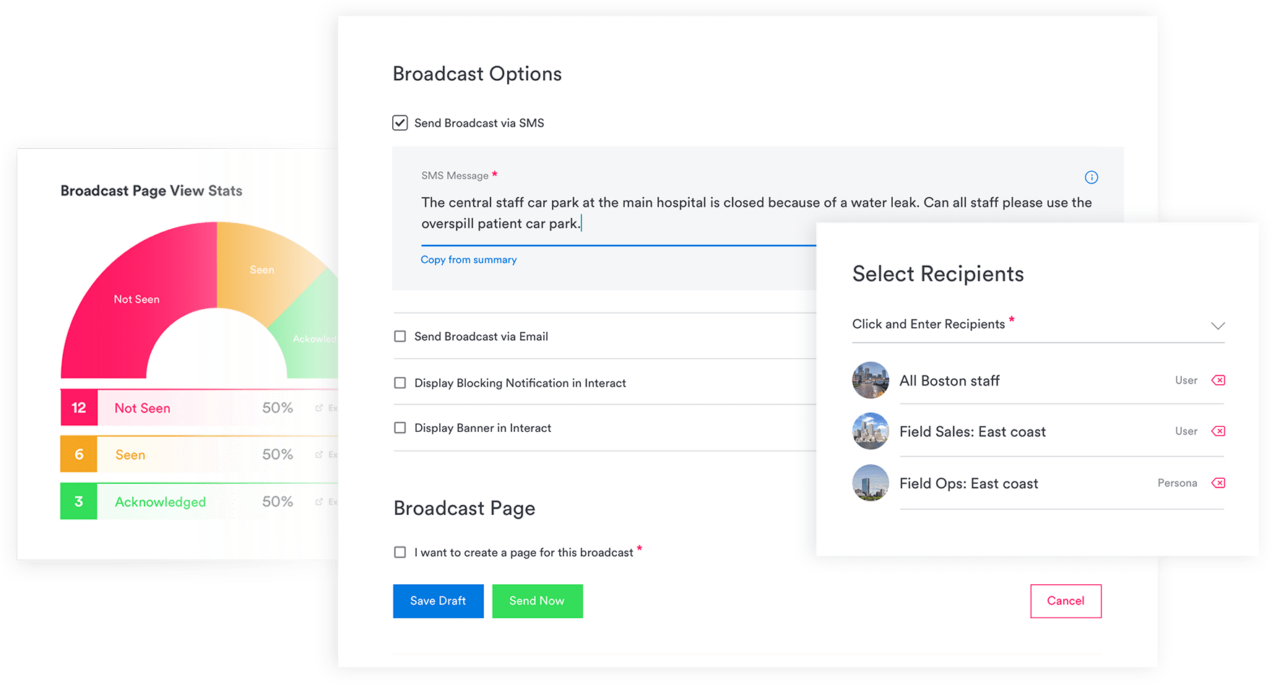Poor communications
Effective communications are crucial in helping organizations to thrive and stay competitive. The right comms strategies drive employee engagement, making workers more productive and adding value across the entire business. They help the entire organization stay in the loop about key company information, news, and events while creating a strong internal brand and a company culture that empowers employees.
However, in today’s digital workplace, it’s harder than ever to capture attention and ensure your communications are resonating. With so many moving parts in our working world, many companies find that their comms aren’t making an impact or get lost in the shuffle.
When a company has poor communication, the effect can reverberate through the organization, leading to significant cultural issues and widespread dissatisfaction. It’s important to regularly assess the effectiveness of employee communications so that you can identify any areas for improvement and take steps to correct them. This article explores how poor communications develop in an organization and offers four ways to fix them.
An intranet can help solve your organization’s toughest challenges
Poor communications in the workplace
A challenge that internal communications professionals face when developing employee comms strategies is needing to understand and engage a very diverse audience with a wide variety of needs and preferences.
This is made even harder by a slew of additional hurdles such as limited resources, differences in work styles (frontline vs. in-person vs. remote), and varied leadership needs and opinions.
When all of these factors come together, it’s not uncommon for comms to suffer.
However, poor communications are a dangerous problem that shouldn’t be taken lightly. Organizations that fail to effectively communicate are more likely to struggle to sustain standard business objectives such as employee retention, engagement, productivity, and even customer satisfaction.
For over 40% of workers, poor communication reduces trust both in leadership and in their team. Remote workers were more affected, with 54% reporting poor communication impacts trust in leadership and 52% reporting it impacts trust in the team. For on-site workers, poor communication did not impact trust to the same extent, though it still had a big impact: 43% reported trust in leadership was impacted and 38% said trust in their team was affected.
Forbes
It’s important to stay vigilant for signs that your comms aren’t cutting it. Your organization may be suffering from poor communications if you have:
- Limited or excess internal comms channels available to staff
- Frequent misunderstandings or mix-ups between colleagues or departments
- Employee complaints about being overwhelmed by notifications from too many apps and platforms
- Inconsistency in the type and frequency of internal communications
- An intranet platform that isn’t meeting company needs
- A leadership team that isn’t on the same page about the role of comms within the organization
- Organizational or departmental conflict
- Lack of regular communication methods such as one-on-ones
- Low employee morale
- A struggling company culture
- High staff turnover
If you’re experiencing any of these situations, it’s time to take a closer look at your comms. Once you acknowledge that there’s work to be done, you’ll be well on your way to creating a better workplace where employees can thrive and organizational goals can be achieved.
An intranet can help solve your organization’s toughest challenges
Four ways to fix poor communications
1. Measure, analyze, and devise a plan
Many comms professionals struggle to measure their internal comms due to limited qualitative and quantitative indicators and therefore avoid the process entirely. However, to stay competitive, you need to know how you’re performing. It’s essential to track the level of engagement with and employee sentiment around your content.
There are a variety of ways to measure how effective your current communications are. A few examples include:
- One-on-ones and group discussions with specific questions that help understand what content and comms methods your staff find most engaging
- Email statistics – check your open and click-through rates for past communications
- Pulse surveys – add a few questions to your next pulse survey that assess how employees feel about the way you’re delivering company information
- Internal and external audits – run an audit of your employee communications content and messaging, or hire a third party to analyze it for you
- Intranet analytics on how users are engaging with your content

The resources you have at your disposal will determine which method is going to be most effective within your organization. If you have robust intranet software, for example, you’ll have many more analytics to work with. If you have a more basic setup, you can still get valuable information through traditional methods, such as email statistics or employee focus groups. Once you’ve gathered some takeaways from these conversations, you can use them to set targets that are aligned with your organization’s goals and objectives.
For example, if employees report being most engaged when receiving updates via video, you may want to set a target to ensure you send out at least two videos a quarter communicating company news.
You may discover in group discussions that employees are overwhelmed with the number of emails they receive. Creating a monthly employee email newsletter instead of sending multiple dispatches each week can drastically reduce the number of emails landing in your audience’s inboxes. Set a rule that you’ll confine less time-sensitive content to that newsletter going forward.
Once you’ve identified what’s working and what isn’t, along with any major issues with your existing communications, you can set these targets and implement the necessary changes. However, this shouldn’t be a one-time exercise; you must continue to monitor, measure, and control your targets to truly improve your comms and engage your workforce for the long haul.
2. Keep communications simple and approachable
Employees are busy. They have projects to juggle, coworkers to meet with, and customers to serve, and oftentimes internal communications will come through while they’re in the midst of these activities. They may only give your messaging a glance or cursory read-through before getting back to what they were doing. The data supports this as well, with a recent study showing the average email only receives nine seconds of attention. This means that if what you’re saying isn’t abundantly clear, its meaning may get lost in the shuffle.

Keep your comms simple and to the point. If you have an announcement to communicate, give a short and basic overview, and then share what this means for individual employees. For example, if there is a new process for employees to submit sick time through your intranet, start with a straightforward description of the change and why it will make employees’ lives easier. Then move on to simple, clear instructions for how to complete the process.
Keeping things organized and brief will ensure that you get the highest quality attention from your audience. If you have the opportunity, run your message by a few coworkers and ask them how easy to understand it is – they may have some fresh insight or spot some unnecessarily complicated language you’ve overlooked.
An intranet can help solve your organization’s toughest challenges
Another important aspect of what makes comms successful is tone. The tone of your messages will, of course, be dictated by the type of information you’re communicating. Announcing the annual holiday party will look different from sharing a major organizational change. But no matter the situation, you need to put yourself in your audience’s shoes and consider any unintended effects of your tone.
For example, let’s say you’re sending an organization-wide email advising of a change to company working hours. Your tone should be professional, but if you lean too formal you may be perceived as harsh or cold. This could result in employees becoming angry or rebellious toward the change. Giving it a human touch, or even simply providing a contact person for employees to reach out to with any questions, can go a long way to making your comms less robotic and corporate, and more relatable. This applies to leadership as well, so if you’re working for them on comms, you may need to tell your boss when their communication needs improvement.
3. Listen to your audience
Employee listening is fundamental to organizational growth and deserves to have a major influence on your internal comms strategy. Many companies say they encourage feedback but don’t take any action to respond or acknowledge it. This is often because they aren’t getting the right type of feedback, lack a dedicated strategy for putting feedback into practice, or are afraid of calling attention to any complaints and unhappiness. Yet not knowing what your audience wants is the source of many poor communications.

For companies that find themselves dealing with poor communications, the natural reaction may be to increase the number of emails, messages, and internal memos. However, an overload of information won’t fix the problem, especially if you’re not listening to employees to see what would add value to their experiences. To truly fix your comms, you’ll need to pause to gather the right data on what your employees want.
Opening several feedback channels can help communicators discover what is causing their problems. It’s important to mix up the types of feedback you’re getting. Employee pulse surveys and questionnaires are popular as answers can be numeric, making the results easier to quantify, evaluate, and find solutions to. However, taking a qualitative approach through individual or group conversations will give you more nuanced, in-depth information. Observing employees’ emotions and body language can make it easier to assess their genuine pain points and challenges, allowing you to better understand your workforce and tailor your comms accordingly.
An intranet can help solve your organization’s toughest challenges
You can also gain valuable information when an employee joins or leaves the company. Onboarding is a great time to find out an employee’s thoughts and first impressions of your communications throughout the preboarding, orientation, and training process. Similarly, incorporating a question or two about comms during an exit interview can reveal a great deal about how effective your employee messaging has been.
Once you have the feedback, you must take action. You need to put together a clear picture of your audience so that you can target your future strategy and messaging. Creating employee personas can be helpful here. Having listened to what your employees want and need, it will be easier to create comms that engage them and make an impact on their workdays. This also means you’ll be better at squashing any potential poor communications in the future before they can do any damage.
4. Harness the right tools
Remote working, flexible hours, dispersed employees, and digital workplaces have made effective internal communications more important – and more difficult – than ever. With so many new developments in the way we work, communicators need solutions that will help them and their entire organizations adapt.
Oftentimes, poor communications are the result of poor technology. In so many workplaces, there are too many channels and platforms, creating confusion about which ones to communicate over. This results in wasted time, notification fatigue, and comms that don’t reach the people they need to.
Implementing a digital workplace solution such as an intranet can improve your internal comms by providing a centralized hub for the whole organization. An intranet makes it easy to disseminate information, giving your company a dedicated forum for top-down, bottom-up, and lateral communication. With an effective intranet, employees know they can access everything in one place, eliminating channel overload and giving everyone what they need, when they need it, no matter their time zones, locations, or roles.

An intranet has the power to segment communications, allowing organizations to adapt messages to user needs and characteristics to get the right info to the right people. It also allows for more engaging formats based on importance and subject matter. Certain messages will get more engagement as blog posts or videos, while alerts are more fitting for others.
Another area where workplace communications often fall short is in reaching the many different types of workers within an organization. To engage everyone, your communications must be easily accessible to employees in various types of roles. Mobile-friendly intranets are very effective at this, as they can be accessed across laptops, smartphones, desktops, and tablets. They allow your comms to reach desk-less workers, who are less likely to be connected. An accessible and centralized intranet will empower them by providing them with the same access to information as their office-based colleagues. A mobile employee communication app can be beneficial in the event of an internal or external crisis, enabling the organization to get a message out and prevent panic, misunderstanding, or confusion.
The right technology can go a long way in rescuing poor communications, so if you’re struggling with your comms, look for ways to get the right tools. When you’re clear on what you need and the benefits it will have for the organization as a whole, it’s easier to make your case, and you’ll soon be on the road to better comms.


